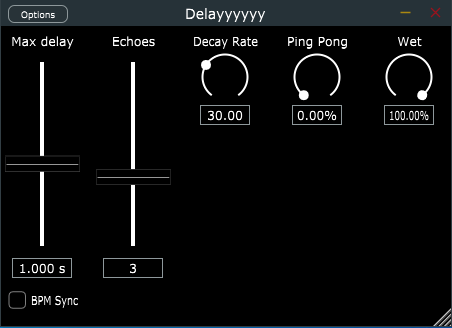Time for a celebration! The 0.1.0 release is here. It took quite a lot of effort to get everything in place and tested. As usual, the last mile turned out to be more difficult than expected. But in the end, things finally felt good enough for the first beta release. I broke the philosophy of having only one logical change in a single pull request by stuffing all the final changes into one PR, sorry about that. In this blog post, I’m going to go briefly through those commits that lead up to the beta release. The section headers are links to individual commits in case you want to judge my code.
Fix bug in short BPM synced delays
So, first things first, the cliffhanger I mentioned in the previous blog post: the bug in the synced delays. The bug was that when there is a high amount of echos, but not enough synced time signature values for them, the plugin went quiet. Instead, there should have been the few short echoes that were available, but still less than the specified amount. This was caused by prematurely breaking out of the loop that creates the delay buffers. Breaking out of the loop would have been fine if we would have been incrementing the iterator (i.e. creating the longest delay first). However, the loop iterates in reverse order (i.e. creating shortest delay first) and thus we can’t break from the loop before going through all synced time intervals.
It may not be a good idea to lie to the user about the final number of echos though.

I finally tried a simple saving of parameters in a digital audio workstation project. As it turns out, empty functions don’t do much of saving (or loading), and when I reloaded the project the carefully set parameters were gone. The solution was simple, actually it only consisted of copy-pasting code from an official JUCE tutorial. Not only for the saving but the loading as well. One feature isn’t much of use without the other.
Get BPM from a possible VST host
This is the big one. Basically, I did the following things to achieve this:
- Run
setDelayBufferParamsin it’s own thread - Read BPM (beats per minute) from the playhead object
- Detect if BPM changes
The first change was done out of necessity to make the second change possible. Playhead is an object that contains audio playback information, like the position of the audio track or the BPM (if available). However, this object can only be read in the processBlock-function. I can’t remember if I’ve mentioned this earlier, but processBlock-function should execute as quickly as possible to keep audio latency as small as possible.
So, we can’t run setDelayBufferParams in the processBlock because we want to keep things smooth. Instead, a separate thread needs to be created and notified in case the BPM (or any other parameter) changes. The thread also checks parameters every now and then by itself. For thread control, I tried to make a sort of one-sided locking where setDelayBufferParams always waits for the processBlock to finish (even if it’s not running, because it’ll run soon anyway), and then hopefully run before the next block has to be processed because the processBlock is a really busy function and it has no time to wait for anything or anyone.
However, thread-control based assumptions that things “should definitely work this way” will fail with 100% certainty. This is no exception. I’ll fix this in a future commit, but please keep this silly design in mind (and then forget it so you won’t create it yourself)

Add plugin header and version info
What’s worse than getting a bug report? Getting a bug report without the version information, or even the name of the product. This commit added a neat little header that shows the name of the plugin, the name of the creator, and even the version in the bottom right corner. I should have dropped the name of the creator though, so no one could send me bug reports.
This commit uses a neat UI feature of JUCE: removeFrom. This can be used to crop (and return) a certain section of the screen area. Something like this is perfect for the headers. Just remove a bit from the top, and the removed area is the new header area! No need to break the existing flexbox-based UI to try and fit header info in there.
Remove negativity, add Fonzie and update TODO
Does what it says, all changes here went to the README. There may be better issue management tools than just updating the README, but at least it’s not as bad as JIRA.

Set the initial values of parameters to default values
This commit sets the initial values of the parameters to their default values. Would you have guessed? Basically makes the code a bit neater. However, this introduced a quite big bug that I somehow missed: the plugin makes no sound before the UI elements are edited because the delay buffers only get created if the parameter values change. If the parameter values are initialized to their default values, the buffers won’t get created before UI changes to something non-default. This programming bug is equivalent to a fist-sized cockroach in real life. I reverted this change here shortly after merging it, but I may need to revisit the idea some other day.
And then I thought that I was ready for the 0.1.0 release. I did some final testing of the plug-in, fiddling around and making sounds. Life was beautiful. Until suddenly, a deafening “pop”-sound occurred. Ableton recorded it to be 173 dBFS. Fortunately, I wasn’t using my headphones, otherwise my head would have exploded. People from miles away heard the sound of my mistake, which was slightly embarrassing.

Well, the reality is a bit less exciting to be honest. The sound wasn’t that loud, and I guess Ableton just calculated it “a bit” wrong. But there was a pop, and it was reproducible easily: just by wiggling the controls of the plugin for a minute or two.
And this is where my “slightly” “stupid” approach to thread control comes in.
Fix race-condition in setDelayBufferParams and processBlock
Basically, it’s dumb dumb very very dumb to assume that some things can and will always run in a certain time frame. In the end, it’s better to have a bit more latency than weird popping audio artifacts. Basically, the sound occurred when setDelayBufferParams didn’t finish before the processBlock was called. As you remember, processBlock waits for no one. So setDelayBufferParams was happily replacing/removing the delay buffers and processBlock was happily reading those garbled memory locations, and a pop sound occurred. That’s why I added a wait to the processBlock so that it won’t run too early. Not the best possible design, but it’ll have to do for now (and most likely until the end).
Add companyName for VST information
Finally, while testing out the plug-in I noticed that the company name wasn’t set correctly (it said yourcompany or something like that), so I fixed it to point to my musical alter ego.
And that’s it! That’s the story of how 0.1.0 came to be. I made one final PR where I added the ready-built x64 VST3-file and updated the README with the known issues of the plugin being a CPU hog and popping occurring while editing parameters. The CPU optimization is worth another story, but I already have a few ideas for that (and for the popping as well). But meanwhile, you can download the VST3 plugin here:














